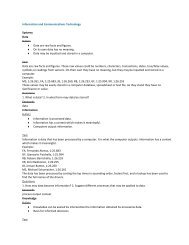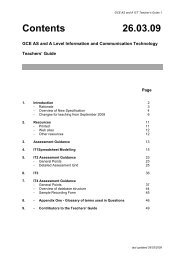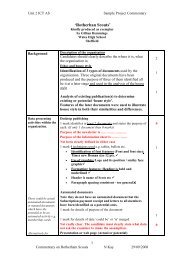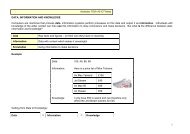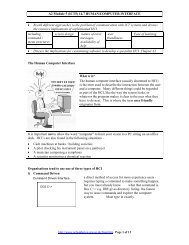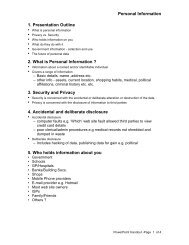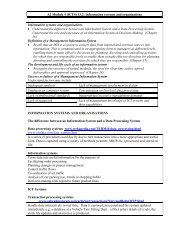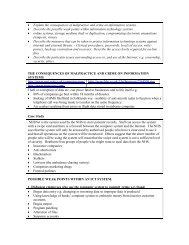Computers in Education - AS Level ICT WGS
Computers in Education - AS Level ICT WGS
Computers in Education - AS Level ICT WGS
Create successful ePaper yourself
Turn your PDF publications into a flip-book with our unique Google optimized e-Paper software.
<strong>ICT</strong> and Learn<strong>in</strong>g<br />
A) Access to sources of <strong>in</strong>formation<br />
(i) The Internet provides;<br />
• Access to onl<strong>in</strong>e databases e.g. Encarta, worlbooks<br />
• Libraries, newpapers and journals<br />
• Specialist sites e.g. history sites such as Spartacus<br />
• Specialist search tools e.g. ‘Endnotes’ used to locate<br />
every book or article published on a certa<strong>in</strong> topic. Law<br />
sites which track details of all law cases.<br />
(ii) CDRoms such as encyclopedias Encarta and tutorials have a<br />
multimedia capacity and can give <strong>in</strong>formation <strong>in</strong> the form of text<br />
sound and video. .<br />
B) Computer Assisted Learn<strong>in</strong>g (CAL) / Computer based<br />
Tra<strong>in</strong><strong>in</strong>g (CBT)<br />
This can range from learn<strong>in</strong>g to use a spreadsheet to flight<br />
simulator tra<strong>in</strong><strong>in</strong>g<br />
<strong>Computers</strong>, and particularly multi-media systems can be used for<br />
education and tra<strong>in</strong><strong>in</strong>g.<br />
There are several types<br />
• Tutorials<br />
• Drill and practice (Repeat over and over aga<strong>in</strong>).<br />
• Simulations<br />
• Games<br />
• Tests<br />
(i) Many software packages come with 'Tutorial' sessions, which<br />
allow the user to learn by follow<strong>in</strong>g simple <strong>in</strong>structions on the<br />
computer. They can be used for teach<strong>in</strong>g Maths, <strong>ICT</strong> etc. Questions<br />
might be asked and the session cont<strong>in</strong>ues only if the user enters<br />
the correct answer.<br />
(ii) Spell<strong>in</strong>g programs which have an <strong>in</strong>teractive component test<strong>in</strong>g<br />
student with games, quizzes and tests. A scor<strong>in</strong>g system allows<br />
students to assess their progress. Often after 3 tries the answer or<br />
clues will be given to them. Picture and sound are used to enhance<br />
the experience.<br />
(iii) Laserdisc technology is be<strong>in</strong>g used for <strong>in</strong>teractive video<br />
simulations. eg highway code, driv<strong>in</strong>g lessons, fire officer tra<strong>in</strong><strong>in</strong>g.<br />
(iv) Virtual Reality systems are be<strong>in</strong>g developed where the user<br />
puts on a helmet which projects images <strong>in</strong>to the eyes us<strong>in</strong>g small<br />
computer screens. Although great for computer games, there are<br />
serious uses as well. VR systems are be<strong>in</strong>g developed to help<br />
student surgeons; a CAT (Computer Aided Tomography) scan can<br />
create a 3-dimensional picture of the human body. A surgeon can<br />
put on a VR helmet and feel as if he is walk<strong>in</strong>g around <strong>in</strong>side the<br />
patient! He can view eg a tumour from different angles etc..<br />
(v) Revision programs eg. GCSE byte size<br />
C) Distance Learn<strong>in</strong>g<br />
Students may not always be <strong>in</strong> the same place as the teacher.




